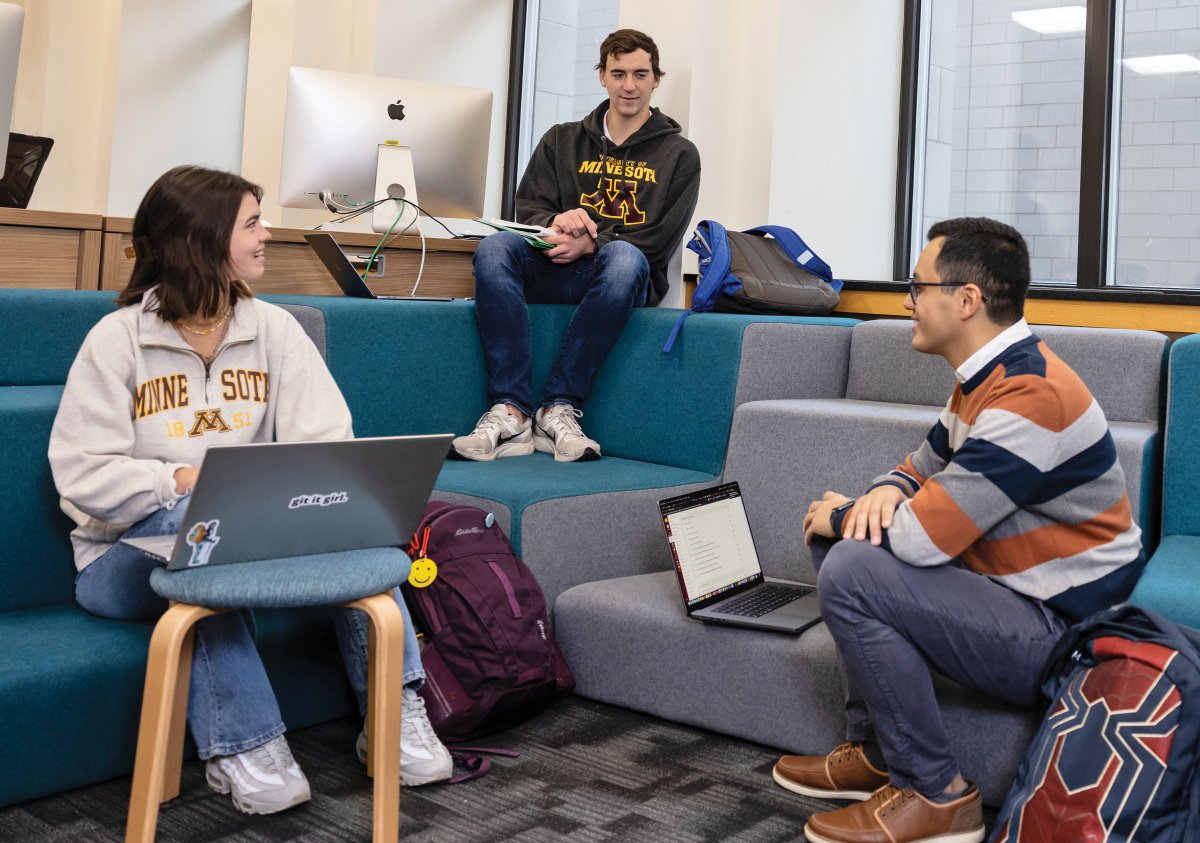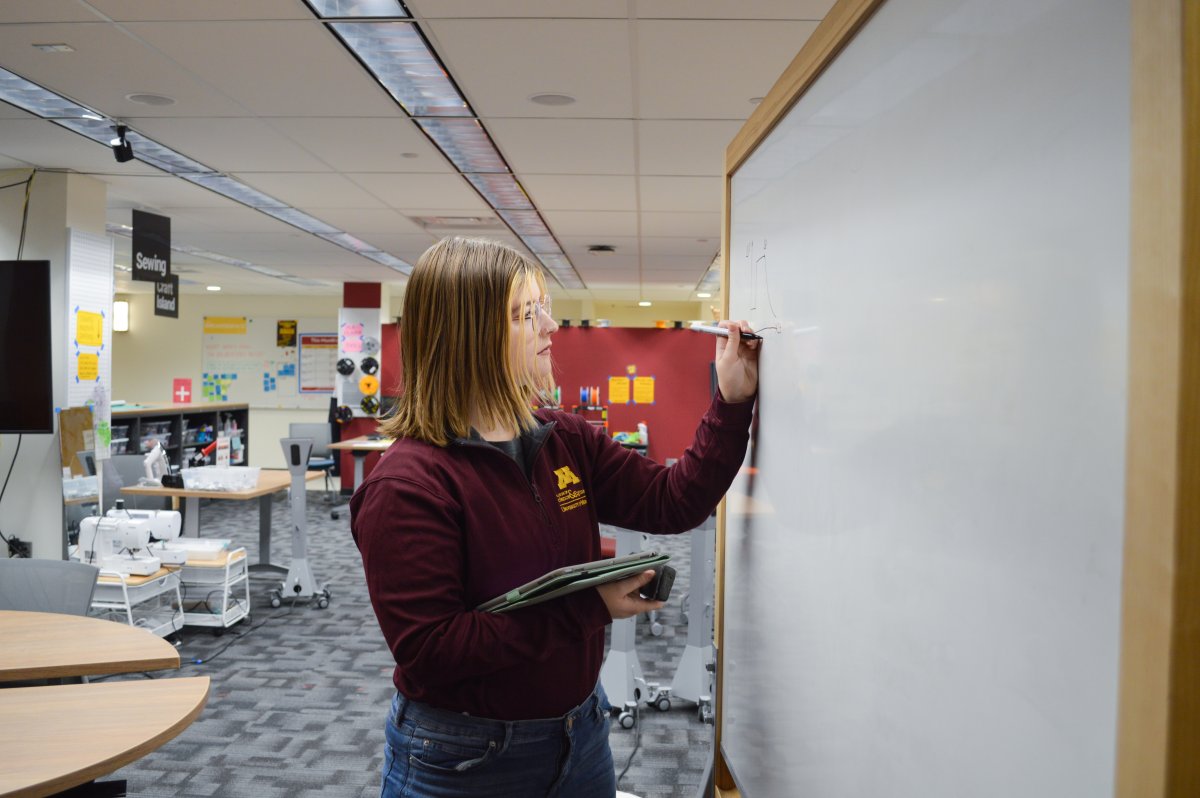Double duty
Adel Elmahdy has long been interested in building things. As a child growing up in Japan, it was Legos, miniature cars, robots— anything his parents put in front of him. Elmahdy turned his passion for piecing things together into a B.S. in electrical and electronics engineering and an M.S. in wireless communication in Egypt before landing in Minnesota.
Here, he’s pursuing a Ph.D. in electrical engineering and two more master’s degrees, one in mathematics and another in computer science.
“In order to solve a significant problem, you cannot limit yourself to a specific discipline,” Elmahdy said. “Having this variety of backgrounds has really shaped me into a better theoretical computer scientist who can handle a broader set of challenging problems in machine learning.”
Elmahdy’s research at the University of Minnesota focuses on using mathematics to understand the intricacies behind machine learning algorithms. His work has many applications, which include refining online product recommendation systems and improving rankings algorithms on apps like Amazon.
Elmahdy was drawn to the University of Minnesota by his advisor, Department of Electrical and Computer Engineering Associate Professor Soheil Mohajer, whose research lies at the intersection of math, engineering, and computer science.
Intersections are somewhat of a specialty for the College of Science and Engineering. CSE is the only college at a major research university in the United States that brings the engineering, computer science, mathematics, and physical science departments together into one college.

This interdisciplinary, collaborative atmosphere impacts the faculty— who can more easily partner with colleagues from the standpoint of sharing resources—as well as benefits the students. Undergraduates and graduate students at the college get to tap into a deep, unique well of options for learning and future careers.
For CSE senior Ashlie Hamilton, it wasn’t the excitement of building things that drew her to science and engineering. It was actually the destruction of things—“things” being the robots that were a part of her older brother’s National Robotics League team, a club at her former high school in St. Paul, Minn., where students build robots to face off against each other in combat.
“It was really my brother and watching his robots that got me into science,” explained Hamilton. “I thought it was so cool watching them destroy each other and ruin all their hard work! That was the clicking point where I realized I wanted to go into STEM.”
Now, Hamilton’s focus isn’t so much destroying machines as it is exploring the materials that go into making them. She’s majoring in materials science and engineering with a minor in astrophysics. One of her future goals is to work with materials that are used in space.
Hamilton works in Department of Chemical Engineering and Materials Science Professor Nathan Mara’s lab, picking apart the nuances and mechanical properties of titanium nitride, a metal ceramic composite material.
“I’m doing the fundamental research in order to maximize the properties that this material can have,” Hamilton said. “From there, engineers can take that and apply it when they’re building semiconductors, electronics, and aerospace vehicles.”

Computational skills are something that CSE senior Annie Bonde is very familiar with. Bonde came to the U as a freshman studying biomedical engineering because she was interested in medicine. She added computer science as a second major after taking her first programming class.
“I quickly realized that there’s a big gap between engineers and computer scientists,” said Bonde, who received the CSE Alumni Scholarship and Maxmillian Lando Scholarship. “I felt like it would be really cool for me to merge those two fields together. I think combining science and engineering is more important than people realize, because you can’t build off of scientific principles that you don’t fully understand. If you’re trying to design a device that performs a certain function and you can’t figure out the best way to optimize the software behind it, it’s not going to reach its full potential.”
During her first year at the U, Bonde worked as a research assistant in the College of Biological Sciences on synthetic cell development with faculty members Kate Adamala and Aaron Engelhart. There, she was able to put her CSE expertise to good use and introduced computational biology to the lab by developing a computer program for culling bacteria.
It was that research experience that inspired Bonde to apply for the Summer Undergraduate Fellowship in Sensor Technologies at the University of Pennsylvania after her junior year. She spent the summer working on magnetometer sensors that could allow the brain to send signals to external devices, such as a prosthetic limb.
“I think my experiences [in Minnesota] have really shown me the importance of having a diverse background,” she said. “I get to learn mechanics, and I get to learn chemical engineering and electrical engineering. I get to learn a little bit of everything, and I think that makes for a really strong engineer when you’re able to use knowledge from different fields.”
Industrial and systems engineering (ISyE) senior Mark Borland agrees, though his favorite part of the major is how it combines science, engineering, and business.
Borland is tackling his undergraduate honors thesis, inspired by what he learned about society’s dependence on the electric grid from Department of Electrical and Computer Engineering Professor Paul Imbertson in the interdisciplinary Grand Challenge course “Power Systems Journey.” He plans to take a broader, multifaceted look at this problem and compare how prices are determined in a provider-consumer energy market.
“I definitely think there’s a benefit to taking an engineering approach and looking at business problems,” said Borland, who’s minoring in leadership and management. “If you do the management minor, you also get to see the Carlson [School] curriculum a bit, and you can get a feel for the business side of things and how they learn. It’s cool to learn some of their skills that you wouldn’t necessarily get in a typical engineering curriculum.”
Preparing students for meaningful, well-paying careers is ultimately the goal of any college, and CSE rivals its competitors with the richness and quality it offers. Hamilton, a first-generation college student and recipient of the Ed & Cora Remus Scholarship, is grateful for many chances to explore.

“At the U, I’ve been able to develop myself academically through research and networking opportunities, while also being able to explore and develop myself through other activities outside of the lab,” said Hamilton, who enjoys practicing karate in her free time and also plays baritone in the University of Minnesota Marching Band. “I really like how versatile my degree is. You can either take a more science route and go into research or academia, or you can take a more engineering route and go directly to industry. It opens up a lot of different opportunities for me.”
The right combination of elements is also a boon to Elmahdy. He credits the breadth of knowledge he’s gained from his three degree programs for making his two internships possible.
The first was with Microsoft, where he researched the privacy issues behind Natural Language Processing, or the technology that lends itself to text completion on laptops and other devices. The second was with San Francisco startup Amplitude Analytics, where Elmahdy developed a model for digital product analytics like website user data.
“The degree that I’m getting from the University has allowed me to do these internships in different topics that are totally different from what I’m doing in my research,” said Elmahdy, who plans to continue doing research in some capacity after he gets his Ph.D. “Having access to all the courses from the math department and computer science departments through my program here has really enabled me to tackle new problems, even if they’re out of my comfort zone or out of my expertise.”
Bonde plans to leverage her computational and biomedical background to work in industry for a couple years before applying to medical school. But regardless of her future plans, she hopes to keep integrating science and engineering whenever possible.
“It would be really interesting to work in a field like radiology, for example, and then make it more of an engineering role where I could, say, design an AI program to diagnose certain diseases that you can obtain from imaging,” Bonde said. “Moving forward, I know I’m going to have such a solid foundation that no matter what role I end up in after graduation, I’m going to be able to succeed.”
